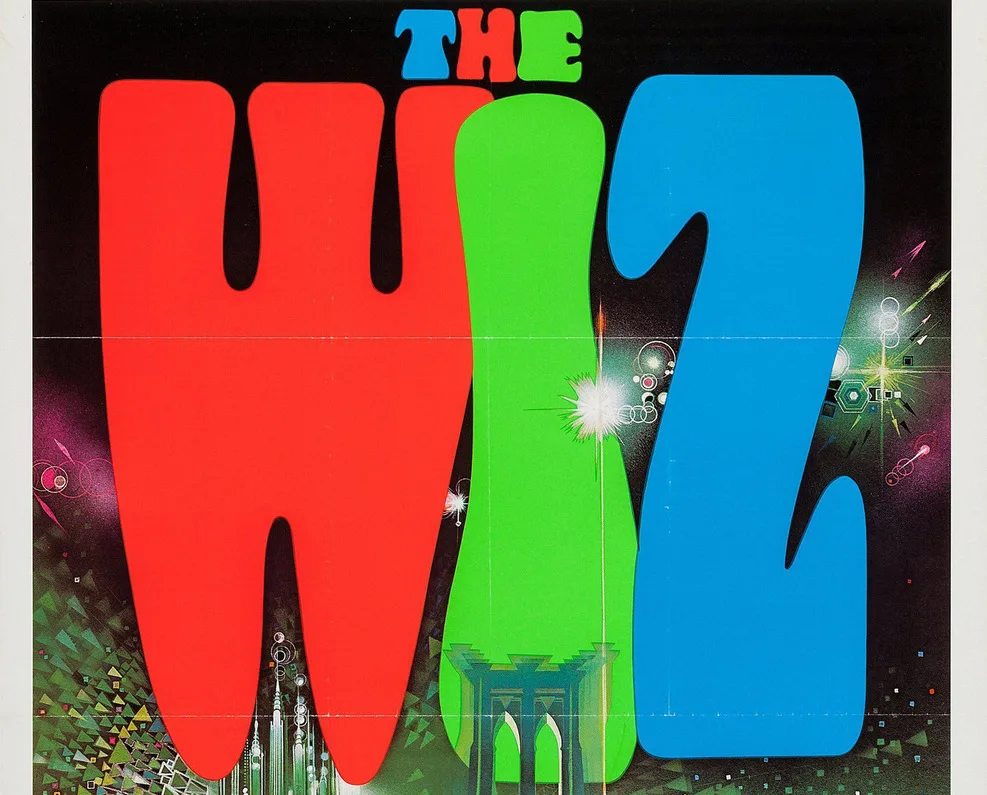Intro
The Wiz stands as a landmark in musical theater. This retelling of The Wonderful Wizard of Oz through the lens of Afrofuturism imagines a world of Black joy, prosperity, and liberation at a time in American history not far removed from slavery and Jim Crow. The 1978 movie adaptation directed by Sidney Lumet with its futuristic urban setting gives off just enough sci-fi vibes to fit into this blog. With Wicked taking the box office by storm this season, it seems appropriate to feature this blockbuster musical as well.
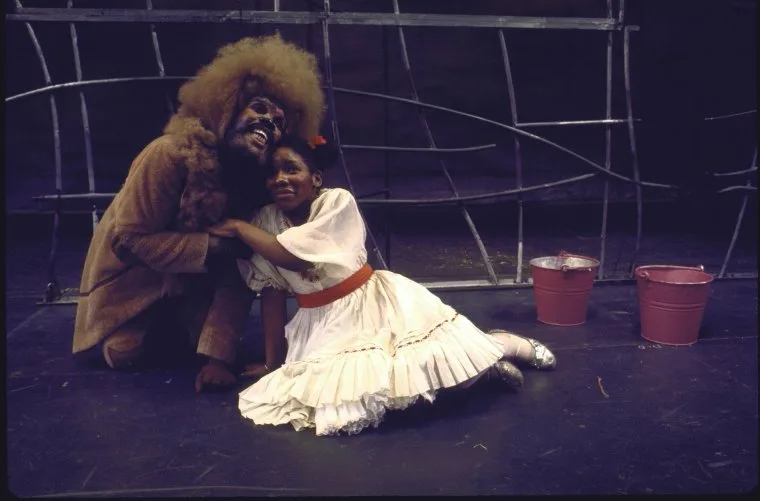
Featured Musical: The Wiz
The Wiz is a musical with music and lyrics by Charlie Smalls and a book by William F. Brown. First premiering on Broadway in 1975, it swept the Tony Awards winning seven including Best Musical. For the past 50 years The Wiz continues to delight audiences on tours and revivals around the world. Notable productions include a recent Broadway revival, a live broadcast on NBC in 2015, and of course, the 1978 film adaptation which has become a cultural treasure.
The idea for the musical was born in Detroit with producer Ken Harper and visionary director Geoffrey Holder. After a few pre-Broadway try-outs in Baltimore and Philadelphia, the show transferred. Harper nearly pulled the plug on opening night due to mixed reviews. However, he took a bold gamble by launching a TV commercial featuring “Ease on Down the Road.” The song gained traction, charting on the Billboard Soul Singles and Hot 100. This move ultimately boosted ticket sales and extending the show’s run for an impressive four years. It became one of the longest running shows at the time. Even Sondheim claimed it as his favorite show that he didn’t write.
Plot Summary
The Wizard of Oz (1939 film, based on L. Frank Baum’s novel) presents a whimsical fairy tale with universal themes framed within a traditional (read: White) American Midwestern setting. The Wiz reinterprets the story through an African American cultural lens, with themes of self-empowerment, identity, and community. In The Wizard of Oz, Dorothy is a White farm girl longing for adventure. Dorothy in The Wiz is also in Kansas as a young Black girl with big dreams of far off places. And the film version, Dorothy is a young Black woman who is afraid of facing the world.
My favorite difference between the two film versions is the choice to set the The Wiz in New York City. Dorothy gets tossed by the cyclone through a neon sign into a dystopian version of the Big Apple. Munchkinland is a graffiti-covered playground, the G-train subway station is a poppy-infused nightmare, the Cowardly Lion is one of the Library statues, the Tin Man is stuck in Coney Island, and the Wiz himself resides at the then newly built World Trade Center. I love New York, and this film is a love letter to every corner of it.
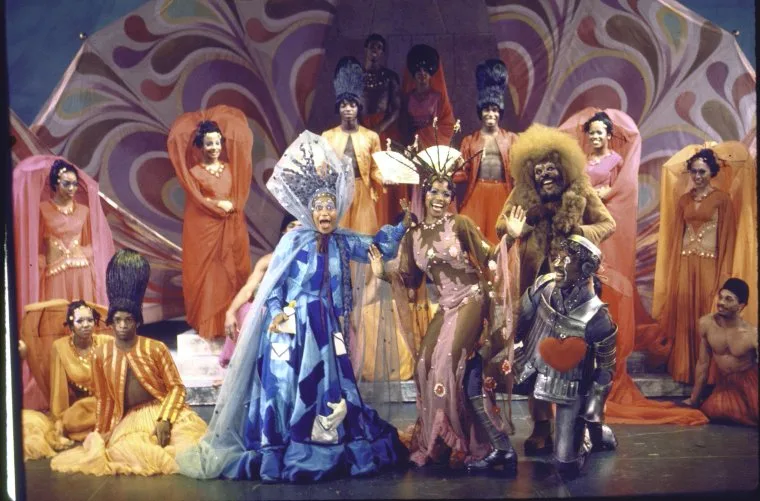
Major Themes
In a 1975 Essence magazine article, playwright Sharon Stockard Martin describes The Wiz as “the story the Black presence in America.” She sees the musical’s plot as a metaphor for displacement, oppression, and slavery as well as deliverance and redemption. She states that it is “a story about removal and restoration of human souls and human bodies, of disillusionment and hope, of self-actualization and survival. It is the story of a coming home.”
According to Angela Washington, Assistant Museum Librarian at The Metropolitan Museum of Art, “Afrofuturism is a genre that centers Black history and culture and incorporates science-fiction, technology, and futuristic elements into literature, music, and the visual arts.” Although the term was not introduced until the 1990s, Afrofuturist themes have been around since the birth of modern science fiction. Drawing from contemporary social movements and popular culture, many Afrofuturist works reflect on the past, critique the present, and envision a hopeful future. The goal is to instill a sense of pride and empowerment in their audience.
Visually and thematically, The Wiz embodies Afrofuturism. It imagines Oz as a world where Black culture is centered in a speculative future, rather than an abstract fantasy. Unlike The Wizard of Oz, which ends with Dorothy waking up to find it was all a dream, The Wiz affirms her journey as real. Ultimately, The Wiz is not just a retelling but a redefinition, transforming Oz into a space of Black pride, cultural expression, and visionary storytelling.
The Music
Song Highlights
“Ease on Down the Road”: This energetic funky song is performed multiple times throughout The Wiz. It is a spirited anthem of perseverance, friendship, and moving forward despite uncertainty. The song helped shift The Wiz into icon status as it became a pop music hit. And watching a young Michael Jackson spin and dance across the yellow bricks makes the journey look almost effortless.
“What Would I Do If I Could Feel?”: Sung by the Tin Man who longs for more than just a heart. He wonders how life would change if he could experience emotions like happiness, sadness, or even the simple joy of shedding a tear. We witness his vulnerability and longing for connection and it’s one of the musical’s most touching and reflective moments.
“He’s the Wizard”: The horns really slap in this lively, gospel-influenced number. It hypes up the Wiz as the ultimate authority–powerful, all-knowing, and capable of solving any problem. Sure, Dorothy gets the idea that he can help her get home only to discover that he is a fraudster who thrives on spectacle. I love the film version where the Munchkins are graffiti shapes that come to life dancing around the fabulously odd Miss One played by Thelma Carpenter. Dorothy’s false sense of hope is a small price to pay for this incredibly catchy tune.
“Can I Go On?”: This is a song that was added for the film and one of the only songs not written by Charlie Smalls. (Quincy Jones wrote it.) It’s a short but deep little glimpse into Dorothy’s fears and feelings about her life and her future. She really needs something (like a crazy adventure!) to knock her out of her self-doubt. The song is also a slow, smooth ballad that contrasts with the high-energy, funk-infused numbers that dominate much of the show. It helps set up the emotional pay off of “Home” as we see Dorothy gain the empowerment she lacks at the start of the show.
“Home”: Yes, it’s the reason we are here. It’s the song everyone knows and loves and it’s because it’s that good. It is the moment when Dorothy finally understands herself and her longing for a place where she truly belongs. It’s one of the most beautiful ballads in the standard American songbook with a rich expressive melody that starts soft and builds to a soaring emotional climax. It is widely regarded as the signature song from The Wiz and it is often performed as a stand-alone song due to its universal themes of love, hope, and self-acceptance.
Characters & Performances
Dorothy: An African American girl/young woman who must navigate a futuristic, urban Oz to discover her own power and identity. Her journey represents a personal and cultural awakening. Notable performances: Stephanie Mills was the original Dorothy on Broadway and she went on to play the role again in the 1984 Broadway revival. She also played the role of Aunt Em in the The Wiz Live! on NBC. Diana Ross requested to play role in the 1978 film but was initially turned down because of her age.
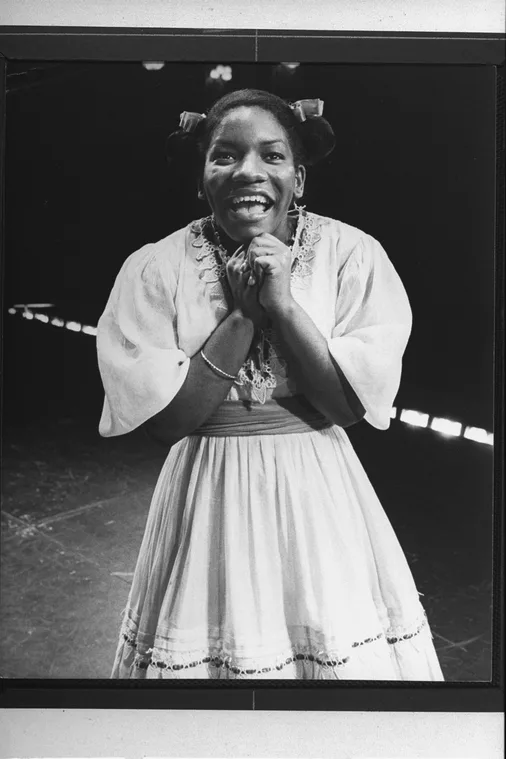
Stephanie Mills in a scene from the Broadway production of the musical “The Wiz”.
The Scarecrow: A character whose quest for wisdom parallels the Afrofuturist theme of reclaiming knowledge and history. As scholar Martin explains, “like a slave stripped of his past…the scarecrow, more than being in need of a brain, is in need of a knowledge of his former self.” Notable performances: Hinton Battle, actor, dancer, director, choreographer, and three time Tony Award winner, was also in the original 1975 Broadway production. Michael Jackson played the Scarecrow in the film version at age 19. He impressed Quincy Jones who later helped him produce his first solo album.

The Tin Man: His search for a heart becomes a metaphor for rediscovering lost emotions and humanity in a world that often dehumanizes marginalized groups. Martin describes the Tin Man as an individual who “develops a hard exterior to protect soft feelings from the inevitable hurt of a hostile environment.” The Tin Man embodies the idea that Black men must be strong to survive. Notable performances: An ex-boxer, Colonel Tiger Haynes portrayed the Tin Man on Broadway. Nipsey Russell was in the film version and is best known for late night TV comedy and panel game shows like Match Game, Password, and Hollywood Squares.
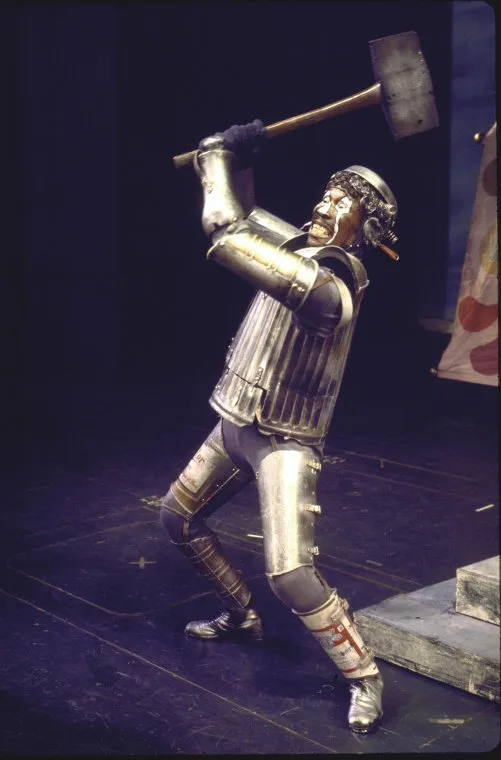
The Cowardly Lion: He seeks courage in an environment that reflects the need for personal and cultural bravery in the face of systemic challenges. Martin views the Cowardly Lion as “a walking contradiction of terms–a negation and self-denial.” He is paralyzed by fear and internalized narratives that distort his behavior, but she believes he only has himself to blame. Notable performances: Ted Ross won the Tony Award for his performance in the original Broadway production and he was one of the only actors asked to reprise his role in the film version. David Alan Grier played the Lion in The Wiz Live! on NBC.
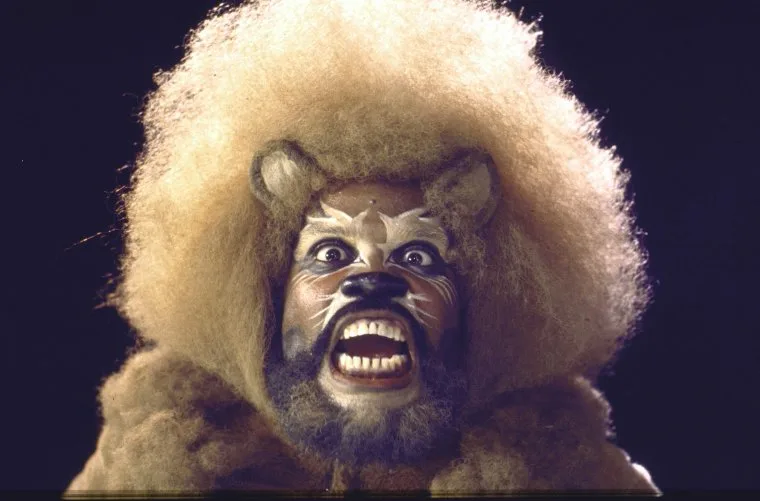
The Witches: The Good Witch of the North, Addaperle (Miss One in the film) is a comedic guide. Wicked Witch Evillene is an oppressive ruler with an industrial, factory-like regime. The Good Witch of the South, Glinda plays a more spiritual role, offering wisdom and self-empowerment. Notable performances: Dee Dee Bridgewater won the Tony Award for her performance as Glinda/Aunt Em in the original Broadway production. Glinda in the film was played by Lena Horne, iconic actress, singer, dancer, and civil rights activist. Thelma Carpenter who played Miss One was also touring in Fosse’s Pippin as Berthe at the same time as filming for The Wiz but the two directors worked it out so she could do both. Mabel King, best known as “Mama” on the popular 70s sitcom “What’s Happening!!” was Evillene on Broadway and in the film.
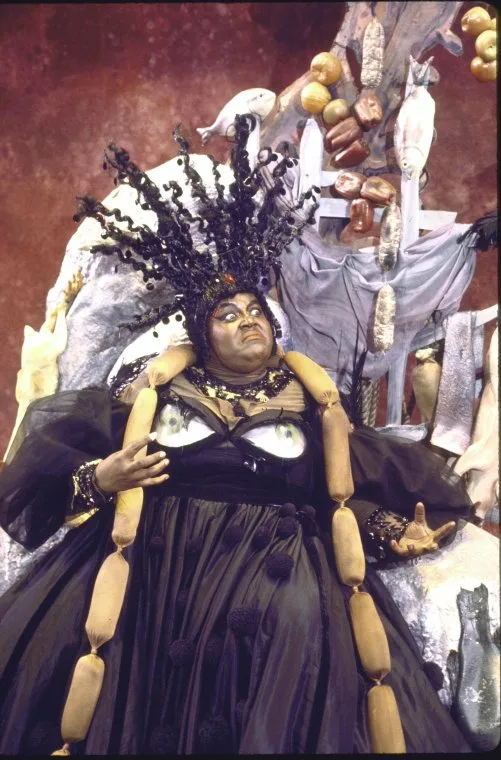
The Wiz: A figure who embodies the illusion of power, his role is a critique on authority figures and systems that claim control over reality. Andre De Shields played the original Broadway Wiz a charismatic showman with a flashy persona. The film version played by Richard Pryor is a sad, small-time conman living in fear. Queen Latifah’s Wiz played with gender in a powerful-yet-troubled interpretation in The Wiz Live!
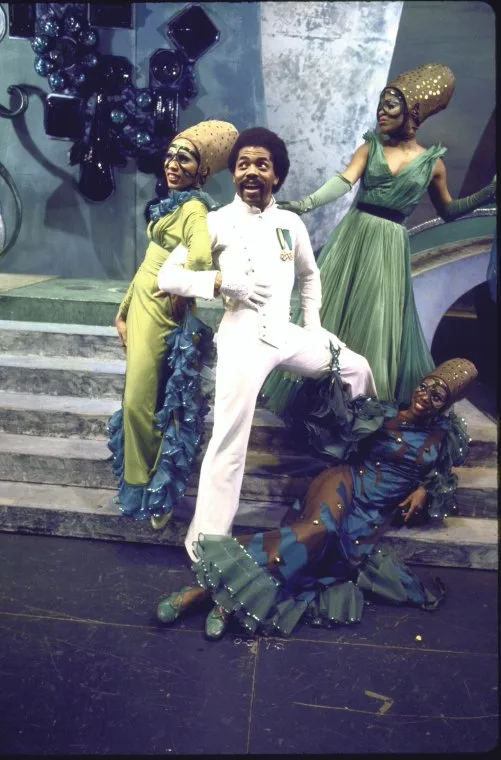
Design Elements
Director Geoffrey Holder was also the original costume designer and he pulled influences and color inspiration from his Trinidadian culture in his vast use of colors and flashy clothes to create most of the costumes. He had a vision for blending the glitz and the glamor with the realities of African American life in the 1970s. Many of these original costumes are now on display at the Smithsonian National Museum of African American History and Culture.
Hannah Beachler, who worked on Black Panther, was the set designer for the 2024 revival. She decided to model Dorothy’s first stop in Oz after Tremé, a historically Black neighborhood in New Orleans complete with an arch inspired by the one in Louis Armstrong Park. She also made sure to include important images within the set that had meaning beyond aesthetics. Ghanan symbols carved on trees were a sign to Dorothy that she was on the right path. And Glinda’s address happened to be 1804, the year of Haiti’s independence.
The amazing and unforgettable choreography was created by George Faison who had been dancing with Alvin Ailey since 1967 and had choreographed three Broadway shows prior to winning the Tony for The Wiz. One of those shows (Via Galactica) will soon be featured on this blog!
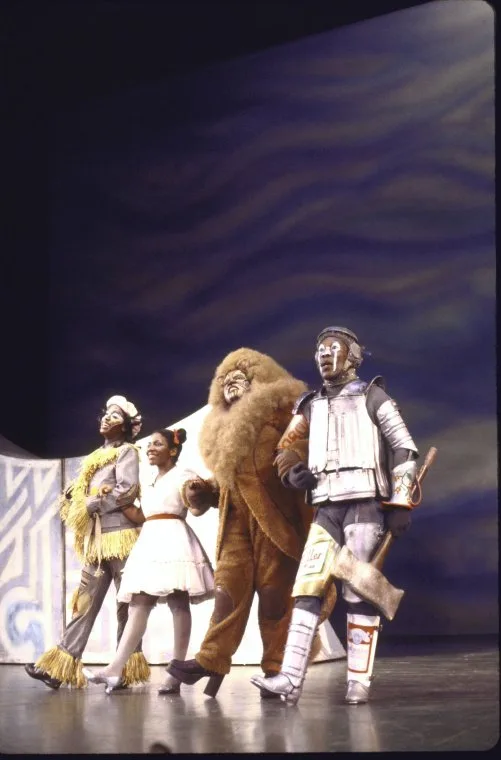
Cultural Impact
The Wiz revolutionized the representation of Black culture in theater and film and had a lasting social and cultural impact. It debuted at a time when Broadway was still largely dominated by White narratives. The Wiz stood out as a bold, unapologetically Black production, offering audiences a story in which Black characters took center stage in a fantastical and empowering world. It was part of the broader “Black is Beautiful” movement of the 1970s, reinforcing messages of Black pride, resilience, and self-worth. Its success, winning seven Tony Awards including Best Musical, proved that Black-led productions could thrive in mainstream theater, paving the way for future shows that center Black stories and artists.
Its legacy is seen in subsequent works that center Afrofuturism and Black speculative fiction, from Black Panther and Get Out to contemporary Black-led Broadway musicals like Passing Strange and A Strange Loop. The 2015 NBC live production as well as the 2024 Broadway revival, featuring a new generation of Black performers, reaffirmed the musical’s enduring relevance and introduced its themes to a younger audience. Ultimately, The Wiz remains a powerful symbol of Black creativity, joy, and the limitless possibilities of reimagining classic stories through a new cultural lens.
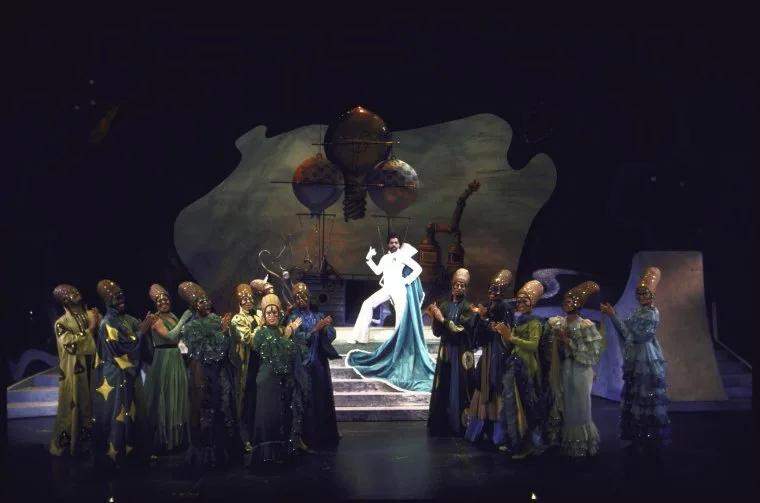
Up Next
Next time, we’re diving into Be More Chill, a sci-fi-infused musical that explores the pressures of high school, identity, and ambition in the digital age. With a mind-controlling supercomputer in the form of a pill, this cult hit blends humor, heart, and catchy tunes to tell a story about what we’re willing to sacrifice to fit in—and what it means to truly be yourself. Don’t miss this high-energy journey into teenage angst with a tech-twist!
References
- “Afrofuturism and ‘The Wiz’ — Ford’s Theatre.” Ford’s Theatre. N.p., 11 Apr. 2018. Web. <https://fords.org/afrofuturism-and-the-wiz/>.
- Billy Rose Theatre Division, The New York Public Library. “Actress Mabel King in a scene fr. the Broadway musical “The Wiz.” (New York)” The New York Public Library Digital Collections. 1974. https://digitalcollections.nypl.org/items/0c760590-5cf5-0130-1314-58d385a7b928
- Billy Rose Theatre Division, The New York Public Library. “Actor Andre De Shields (C) w. cast in a scene fr. the Broadway musical “The Wiz.” (New York)” The New York Public Library Digital Collections. 1974. https://digitalcollections.nypl.org/items/f3642850-5cf4-0130-1147-58d385a7b928
- Billy Rose Theatre Division, The New York Public Library. “Actors (4R-R) Ted Ross, Stephanie Mills, Tiger Haynes & Stu Gilliam (who was replaced prior to Broadway opening) w. cast in a scene fr. the Broadway musical “The Wiz.” (New York)” The New York Public Library Digital Collections. 1974. https://digitalcollections.nypl.org/items/f9e924c0-5cf4-0130-8f85-58d385a7b928
- Billy Rose Theatre Division, The New York Public Library. “Actors (Front L-R) Clarice Taylor, Dee Dee Bridgewater, Ted Ross & Tiger Haynes w. cast in a scene fr. the Broadway musical “The Wiz.” (New York)” The New York Public Library Digital Collections. 1974. https://digitalcollections.nypl.org/items/fa5a7d20-5cf4-0130-a93a-58d385a7b928
- Billy Rose Theatre Division, The New York Public Library. “Actors (L-R) Tiger Haynes, Andre De Shields, Hinton Battle, Stephanie Mills & Ted Ross in a scene fr. the Broadway musical “The Wiz.” (New York)” The New York Public Library Digital Collections. 1974. https://digitalcollections.nypl.org/items/ff026210-5cf4-0130-4ab6-58d385a7b928
- Billy Rose Theatre Division, The New York Public Library. “Actors Stephanie Mills & Ted Ross in a scene fr. the Broadway musical “The Wiz.” (New York)” The New York Public Library Digital Collections. 1974. https://digitalcollections.nypl.org/items/07219770-5cf5-0130-9a11-58d385a7b928
- Billy Rose Theatre Division, The New York Public Library. “Actor Tiger Haynes in a scene fr. the Broadway musical “The Wiz.” (New York)” The New York Public Library Digital Collections. 1974. https://digitalcollections.nypl.org/items/f98fb540-5cf4-0130-1c75-58d385a7b928
- Billy Rose Theatre Division, The New York Public Library. “Stephanie Mills in a scene from the Broadway production of the musical “The Wiz”.” The New York Public Library Digital Collections. 1974. https://digitalcollections.nypl.org/items/9033d8a0-be8c-0136-ab95-27abe8787986
- Filichia, Peter. “THE WIZ AND I by Peter Filichia – the Official Masterworks Broadway Site.” The Official Masterworks Broadway Site. N.p., 15 Dec. 2015. Web. <https://masterworksbroadway.com/blog/the-wiz-and-i/>.
- Kumar, Naveen. “Reviving ‘The Wiz’ through ‘The Blackest of Black Lenses.’” The New York Times 24 Feb. 2024. Web. <https://www.nytimes.com/2024/02/24/theater/the-wiz-revival-broadway.html>.
- Sharon, Stockard M. “THE TANNING OF OZ: REFLECTIONS ON THE USURPATION OF A MYTH.” Essence, vol. 6, no. 5, 09, 1975, pp. 32-32, 35. ProQuest, https://ezaccess.libraries.psu.edu/login?url=https://www.proquest.com/magazines/tanning-oz-reflections-on-usurpation-myth/docview/1818432160/se-2.
- “The Wiz Movie Poster (#2 of 3).” IMP Awards. N.p., n.d. Web. <http://www.impawards.com/1978/wiz_ver2.html>.
- Washington, Angela. “Afrofuturism in the Stacks – the Metropolitan Museum of Art.” N.p., 15 June 2022. Web. <https://www.metmuseum.org/perspectives/library-afrofuturism>.
